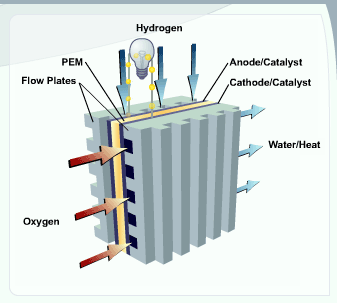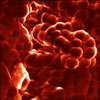An engine to navigate through the arteries

Video frame from Monash University website
Researchers from Monash Universyty belonging to Micro/Nanophysics Research Laboratory have developed 250 micrometers microbot motors. Its name is “Proteus engine” in honour of the submarine miniature that go all over the human body in the movie “Fantastic Voyage”.
The engine uses piezoelectricity as source of energy, which responds to mechanical stress using the ability of some materials to generate electric potential.
Although surgeons and, patients of course prefer minimally invasive operations surgery, it is not always possible to avoid serious harm, such as perforation of an artery by the catheter tube in narrow areas.
The microbot motor created could transport the appropriate sensors equipment to reach inaccessible areas by other ways. Furthermore, the implementation of tiny remote control operated robots, which use this engine as propeller could facilitate the labour of surgeons.
So far, the team that carried out the project also built the engines’ prototypes. Currently they work to improve the assembly of mechanical devices to control the micro-motor.
Electronic miniaturization through nanotechnology

It is well-known that the miniaturization of electronic components is one of the objectives of this industry, often imposed by market demands. Some still remember the space that the first computers occupied or the size of a 5 and 1 / 4” diskette and its storage capacity or the size and performance of the first mobile. People called the first laptops “portable” in a quite generous way, as they were more portable than laptops with a significant effort by the carrier.
Undoubtedly, the amount of miniaturization and performance, as well as the diversity of electronic devices, has advanced considerably in recent decades. The current situation in this area could change dramatically thanks to two recent researches.
The first of these investigations concerns the miniaturization of transistors, which are the main component of these days’ electronics. The University of Pittsburgh has developed very small transistors. This technology could develop devices for high-density memory. Researchers have created a nanoscale one-stop shop, a platform to create a very close to the atom electronic scale.
In March 2008, authorities announced that their process of swapping insulators and conductors works like a microscopic Etch A. SketchTM. Using the sharp conducting probe of an atomic force microscope, created less than 4 nanometers wide cables at the interface of strontium titanate and a 1.2 nm thick layer of lanthanum aluminates, both insulators. A reverse voltage or light can erase the nanowires drivers, reverting the interface into an insulator again.
In their latest work, the authors show that the potential of the process discussed can be adapted to specific uses beyond simple conductors and insulators, applying this technique to the realization of field-effect transistors (FET). Using the technique developed they created a transistor, which they called “SketchFET”. It has characteristic sizes of only two nanometers, which is considerably smaller than the most advanced silicon transistors, which measures are about 45 nanometers and that are miniaturalizables with difficulty, according to the authors.
In addition, other devices such as high-density memories, wired or chemical sensors that could compete with ultrasensitive detectors made with carbon nanotubes can remove at will the transistor “SketchFET”.
Furthermore, a research work developed at the University of Massachusetts has created a thin film capable of storing information of 250 DVD on a coin-sized surface. Three points of nanometers in equidistant size from each other forms the film; they are distributed with a density of 10 terabits per square inch.
For over a decade, Scientifics tried to exploit the property that the molecules in the thin film of block copolymers, which are two or more polymer chains chemically different from each other, that self-assemble in a extremely precise and equidistant pattern when it extends over a surface.
The solution adopted by those responsible for the investigation was to overlay the block copolymers film on the surface of a sapphire crystal. When the crystal is cut at an angle and is heated from 1300 to 1500 degrees centigrade for 24 hours, its surface is reorganized in a very orderly pattern in saw tooth ridges that can be used to guide self-assembly of block copolymers.
According to the authors, there are few length limitations in block copolymers production as there are different-sized crystals. Moreover, you can change the pattern obtained by changing the angle and depth of the saw tooth. The variation happens when the crystal temperature increases.
If these technologies obtain the so promising results that its authors say, maybe in a short space of time we have on our hands an all-in-one device in a space similar to a credit card created to replace the mobile, the laptop and other electronic gadgets that we use today. Will it be the end of briefcases for laptops?
Carbon nanotubes to cheaper make fuel cells

Image obtained from boingboing.net
More than half the cost of fuel cells is due to the platinum catalyst which everybody uses today, making it impossible to be marketed on a large scale.
This February, Science published an article entitled “Nitrogen-Doped Carbon Nanotube Arrays with High Electrocatalytic Activity for Oxygen Reduction”, which proposes the use of arrays of vertically grown carbon nanotubes, which dope theirselves with nitrogen as the catalyst. The way to make the electrodes is depositing carbon nanotubes arrays in a composite polymer film polymer and carbon nanotubes.
Besides its high cost, the platinum has additional problems. One is carbon monoxide that can adhere to its surface making it less effective. The other is that platinum is not very long lasting, so that their properties degrade over time. Carbon nanotubes solve these problems since they have an operational stability for long periods and do not suffer the problems associated with carbon monoxide.
This technology can make possible the use of alkaline fuel cells in the conventional vehicle market. These fuel cells are very efficient but for the time being, its use is limited to spacecraft. Nanotubes are effective in the chemical processes taking place in the alkaline fuel cells.
According to the authors, carbon nanotubes doped with nitrogen must also operate in the polymeric electrolyte membrane fuel cells, which is an option for its use in vehicles.

Polymer electrolyte membrane fuel cell. Source: Wikipedia
Nanotechnology to desalinate water

Representation of capacitive deionization process. Image obtained from Proingesa website
Nowadays there are different techniques to desalinate water but they all require a high-energy consumption and significant investments in the construction of desalination plants.
Reverse osmosis is the best desalination technique existing today. The two main limitations of this technique include the need to maintain high pressure and the use of membranes for processing.
The company Proingesa and foundations IMDEA Energía and IMDEA Agua will carry out a research project to develop a device for low cost capacitive deionization. This device is nanomaterials based, the type developed for latest generation of electrochemical capacitors.
Early studies of capacitive deionization were 40 years ago, indicating that this technique could be a viable option to desalinate water cheaply. So far, the big problem of this technique was the lack of suitable materials.
Capacitive deionization process, shown in the figure, consists of two stages of deionization and regeneration. The first applies an external electrical load on the two electrodes submerged in water to treat. This causes the moving of the ions dissolved in the water toward the opposite electrode, and its absorption. At the stage of regeneration, power supply to the electrodes interrupts, being released ions retained. In this process, if an external electrical circuit connects to the electrodes, it generates an electric current similar to the way during the discharge of a capacitor.
Maybe, thanks to the development of appropriate nanomaterials, low cost desalination of water will be possible in the near future and will minimize the problems associated to drinkable water shortages.
Another look at INL construction site

Construction work at the INL is going on nonstop. Here is a look at the building where most of the Labs and offices will be. If you want to know more about the INL project, visit us at http://www.iinl.org.
New Generation of Orthopaedic, Dental And Cardiovascular Prostheses

Image obtained from pacificnanotech.com
A research conducted by scientists from the Université de Montréal in collaboration with McGill University, the Institut National de la Recherche Scientifique (INRS-EMT), Plasmionique Inc. and the University of São Paulo, could provide a breakthrough in the field of medical implants.
A major concern in the introduction of prostheses is the possibility of a body rejection. The research mentioned above could mean a breakthrough in finding a solution to this problem through application of advances in nanotechnology.
According to the authors, with the use of chemical modifications it is possible to produce intelligent metal surfaces metals that will help the cells to control their biological response facilitating healing. During the investigation, they have used chemicals to modify the surface of metals used commonly in biomedicine, such as titanium. It is possible to obtain sponge-like patterns with areas of nano pits exposing these metals to selected etching mixtures of acids and oxidants.
The study analyzed the influence of nanoporos produced on the surface of titanium on the growth and cell development, showing that these surfaces promote the growth of bone cells, and reduce the growth of unwanted cells and stimulated stem cells.
The uncontrolled growth of these cells represents a problem on their interaction between the metal surfaces, as they may interfere with blood flow when used in cardiovascular stands or form capsules around dental implants –used for this purpose causing them to fail. However, the authors argue that with subtle changes in chemical composition of the etching mixtures it is possible to control the nanopatrones created in the metal surface and thereby control cellular responses.
This development could influence positively to the successful implementation of orthopaedic, dental and cardiovascular prostheses eliminating side effects and the need for drugs, and making the implants work actively with the biological environment in the healing process.
INL at the International Nanotech 2009 Conference in Tokyo
<!–[if gte mso 9]> Normal 0 21 false false false MicrosoftInternetExplorer4 <![endif]–><!–[if gte mso 9]> <![endif]–><!–[if gte vml 1]> <![endif]–><!–[if !vml]–><!–[endif]–> INL is currently attending the world’s largest nanotechnology exhibition The NanoTech 2009. This meeting covers the entire nano marketplace and it’s the ideal place to meet researchers, academics and investors interested in Nanotechnology and Nanoscience.
INL is currently attending the world’s largest nanotechnology exhibition The NanoTech 2009. This meeting covers the entire nano marketplace and it’s the ideal place to meet researchers, academics and investors interested in Nanotechnology and Nanoscience.
If you want to meet INL people, don’t hesitate to visit the Spanish Hall of the the Conference Tower at Tokyo. INL is located at Booth No. B-36.
Biosensor for diagnosing diseases
 Scientifics developed in the 70s the method for diagnosis of diseases used today. This system is blood and urine tests based to detect and diagnose diseases, requiring laboratories and personnel. This protocol is economically and time costly, requiring at least two hours to perform the necessary tests.
Scientifics developed in the 70s the method for diagnosis of diseases used today. This system is blood and urine tests based to detect and diagnose diseases, requiring laboratories and personnel. This protocol is economically and time costly, requiring at least two hours to perform the necessary tests.
A device developed by researchers at the University of Leeds could reduce the time of diagnosis to a few minutes, and allow testing in the doctor’s own practice, that is allowing a faster diagnosis, less expensive and more convenient for the patient. The system uses antibodies to detect corporal molecules used to identify physical diseases, called biomarkers, in blood and urine.
The project ELISHA developed the diagnostic device, which has the size of a credit card payment machine, but they expect to reduce its dimensions to a mobile phone size.
The system has a similar function to existing diabetics glucose biosensors, that report with a simple yes or no if exists a wide range of diseases such as prostate cancer or ovarian cancer, multiple sclerosis or heart diseases.
The authors suggest other possible uses of the device such as the detection of herbicides or pesticides in the water or the presence of antibiotics in milk.
In three years is expected to start its marketing. Maybe then the trauma experienced by patients in the series “House” until the famous doctor gets final diagnosis will go even further from the truth than nowadays.
New Electrode for Lithium-Ion Batteries

Coaxial manganese oxide/carbon nanotube (CNT) arrays deposited inside porous alumina templates were used as cathodes in a lithium battery. Source: Nano Letters
We currently use a large number of electronic devices powered by rechargeable batteries such as laptops, mobile phones, cameras and video game consoles, some of the toys of our children, for example. In addition to these uses we can imagine many others who would become important if there is a large battery storage capacity, such as its use to fuel vehicles.
All this leads to the development of technologies related to the efficient storage of electricity is one of the highest demands of our society.
Researchers from la Rice University have developed a technology that, according to the authors, could substantially increase the capacity and number of charge/discharge of the lithium-ion batteries.
The research team led by M. Pulicket Ajay, created hybrid carbon nanotube arrays as metal oxide electrode material. In combining technology developed for the realization of carbon nanotube electrodes, which is a great conductor of electricity and manganese oxide, which has a large capacity. Although this combination was already used to manufacture electrodes, the novelty of this work is available in the form of used coaxial cable. In this case, nanotubes are punishable as a coaxial cable consisting of a high conductor nanotube core and a manganese oxide shell.
According to the authors, this technology could lead to the development of small and flexible batteries.
The article appears in the digital version of the American Chemical Society’s Nano Letters.
Gecko-Inspired Drug Delivery Device

Image obtained from Nanosys web page
It has long been trying to deliver medication through the mucous membranes, being a good choice for this purpose due to its large area and its rich blood supply. Compared to the advantages already discussed, the mucous membranes are an effective natural barrier that protects us from the entrance of substances, which hinder the administration of medication for that route.
Chemical modifications to improve the adhesion properties were the base of the attempts made so far for the administration of medications through the mucous membranes.
Nanosys Inc. has recently submitted the results of initial studies of Gecko-Inspired drug delivery device. This silicon nanowire mucous membrane drug delivery device has been carried out with a nano-structured surface adhesion properties of which are based on the Van Der Waals forces of adhesion. This novel design results in silicon nanowires adhere to the cells below the mucus, allowing a longer residence time, enhancing the local concentrations and allowing a better absorption systems where the medication is directed to tissues.
This study also showed that the amount of mucosal shear force the silicon nanowire-based could withstand being Elimite is 100 times higher than a non-silicon nanowire device. In addition, silicon nanowires have a low production cost and are biocompatible.
